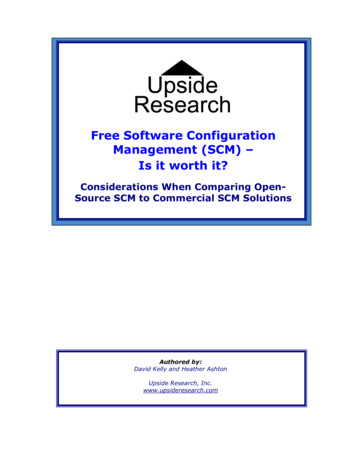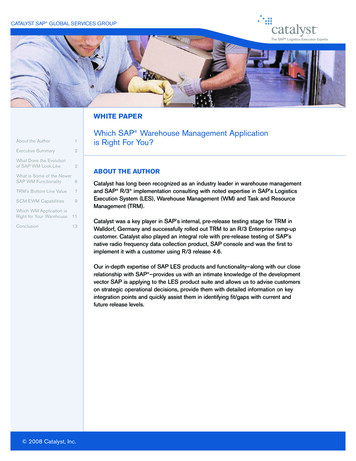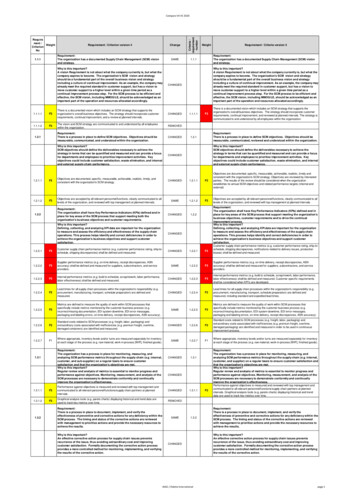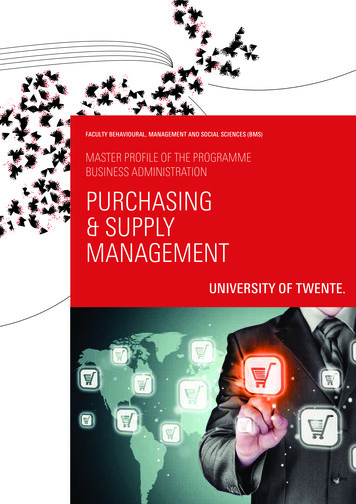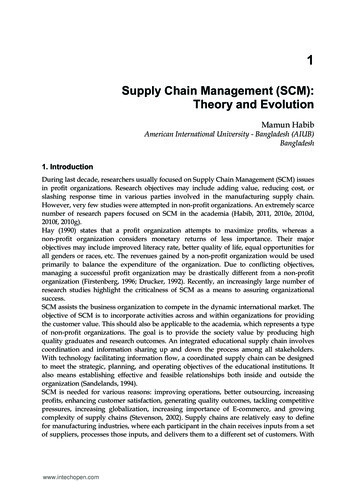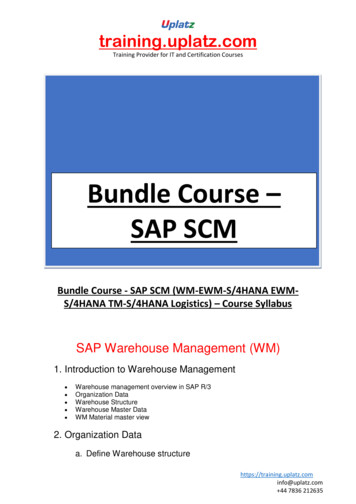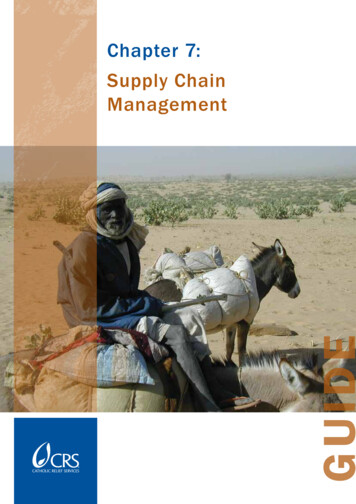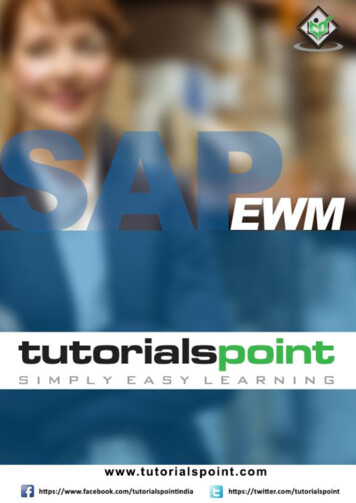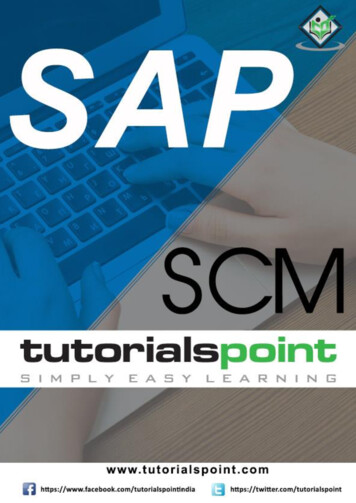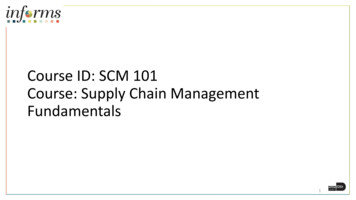
Transcription
Course ID: SCM 101Course: Supply Chain ManagementFundamentals1
Ground RulesBe on timeAttendanceTurn off your cellphones when inclassTake breaks asneededParticipate activelyin class; refrainfrom email andinternet useFeel free to askquestions
Course OverviewCourse DescriptionThis course provides a comprehensive review of the Supply Chain ManagementFundamentals processes.This course consists of the following modules: Module 1: Course Introduction Module 2: Supply Chain Management Fundamentals Module 3: SCM End-to-End Processes Module 4: Integration points between SCM and Finance INFORMS modules Module 5: Course SummaryTraining Audiences All INFORMS end-users with SCM Related RolesPrerequisites ERP 101 – Overview of INFORMS ERP 102 – INFORMS Navigation, Reporting and Online HelpEstimated Duration 1 Hour and 30 Minutes3
Course OutlineContentModule 1: Course IntroductionModule 2: Supply Chain Management Fundamentals Lesson 1: INFORMS SCM FundamentalsModule 3: SCM End-to-End Process Lesson 1: SCM End-to-End Processo Lecture 1: Strategic Sourcing Module End-to-End Processo Lecture 2: Supplier Contract Management Module End-to-End Processo Lecture 3: eProcurement Module End-to-End Processo Lecture 4: Procurement ReportingModule 4: Integration points between SCM and Finance INFORMS Modules Lesson 1: Integration points between SCM and Finance INFORMS ModulesModule 5: Course Summary4
Module 1: Course IntroductionModule TopicsCourse Administration and LogisticsLearning ObjectivesRoles and ResponsibilitiesNavigationKey Changes to the Business ProcessIntroduction to Demonstrations, Activities and Exercises5
Course Administration and LogisticsTo receive credit forcompleting this course,attendance mustbe recorded at thebeginning and end ofclassActively participate inclassAsk questions tolearnPlease turn off cell phonesand refrain from checkingemail and the Internet whilein classTake Breaks atscheduled timesBe back from Breakson time6
Learning Objectives Understand the fundamentals of INFORMS Supply ChainManagement (SCM) Understand the SCM end-to-end processes Understand the Integration points between SCM and FinanceINFORMS modules7
Roles and Responsibilities All INFORMS end-users with SCM related roles are required to takethe SCM 101 – Supply Chain Fundamentals course prior to takingsubsequent SCM courses8
NavigationBelow are the steps to navigate to Account Payables, which will be used fornavigation in the rest of this course:1. Login to INFORMS and select Finance/ Supply Chain (FSCM) from the homelanding page below:9
Navigation2. Select Supply Chain Operations.10
Key Changes to the Business Process The ability to manage the lifecycle of capital projects and theprocurement of goods and services Provides the functionality to request, solicit, contract, procure,receive, and pay for goods, services11
Introduction to Activities and ExercisesParticipants will take part in two types of hands-on learning throughoutthis courseTrainingActivitiesTrainingExercises12
Module 1: Course Introduction SummaryModule TopicsCourse Administration and LogisticsLearning ObjectivesRoles and ResponsibilitiesNavigationKey Changes to the Business ProcessIntroduction to Demonstrations, Activities and Exercises13
Module 2: Supply Chain ManagementFundamentalsModule TopicsModule IntroductionLesson 1: INFORMS SCM Fundamentals14
Lesson 1: INFORMS SCM Fundamentals Introduction to INFORMS SCM Fundamentals and its features andbenefits15
Lesson 1: INFORMS SCM Fundamentals INFORMS provides the ability to track and report on the goods andservices purchased from County contracts across all agencies All assets and expenditures will be tracked and maintained in onecentral system16
Lesson 1: INFORMS SCM Fundamentals17
Lesson 1: INFORMS SCM FundamentalseProcurement Manage Items and Catalogs Manage RequisitionsThis module initiates the procure-to-pay business process by providingthe functionality to request goods and services for purchase. In thismodule user will create and maintain requisitions to include,integrating with the County’s e-catalog to select items and process theitems through the INFORMS requisition.18
Lesson 1: INFORMS SCM FundamentalsSupplier Contract Management Create Supplier Contracts Manage Contract Deliverables Negotiate Supplier Contracts Amend Supplier Contracts Approve Supplier Contracts Manage Supplier Contract Execute Supplier ContractsStandardsThis module provides robust document management authoringcapabilities to create and manage written contracts, sourcing events,purchase orders, and ad hoc documents using Microsoft Word. Themodule also provides a structured method to develop and manage acontract clause library and the document management life cycle.19
Lesson 1: INFORMS SCM FundamentalsPurchasing Manage and Record Purchase Orders Record Receipt of Goods & ServicesThis module is the center of the procure-to-pay process. It willstreamline the purchasing process through the creation ofProcurement contracts, purchase orders, and receipts.20
Lesson 1: INFORMS SCM FundamentalsStrategic Sourcing Manage Bidders Manage SourcingThis module facilitates collaboration between procurementprofessionals in user departments and the suppliers of the goods andservices. Users will use the Strategic Sourcing module to manage andexecute the bidding process.21
Lesson 1: INFORMS SCM FundamentalsSCM Integration Across Business Processes During the SCM process, the SCM modules integrates information across businessprocesses to complete the procure-to-pay life cycle which provides real-timevisibility and transparency to data throughout the County.eProeProcurement (ePro)Purchasing (PO)Strategic Sourcing (SS)Supplier Contract Management (SCM)XXPOXXXSSXXSCXXX22
Lesson 1: Activities and Exercises23
Module 2: Supply Chain ManagementFundamentals SummaryModule TopicsModule IntroductionLesson 1: INFORMS SCM Fundamentals24
Module 3: SCM End-to-End ProcessesModule TopicsModule IntroductionLesson 1: SCM End-to-End Processes25
Lesson 1: SCM End-to-End ProcessesAt the conclusion of this lesson, participants should: Understand the details of the SCM modules’ end-to-end Processes26
Lesson 1: SCM End-to-End ProcessesThe SCM modules support the business process of procuring goods andservices from suppliers in order to continue business operations.Business processes include actions involving requisitions, purchaseorders, change orders, receipts, procurement contract, sourcing eventsand creating supplier contract management documents.27
Lesson 1: SCM End-to-End Processes28
Lesson 1: Key TermsTermDefinitionAgreementsAgreements, also called deliverables, provide a mechanism to define andmanage internal and external agreements for the contract.BidA submission of a response to an event.BidderOrganizations that are interested in doing business with the County andinterested in responding to solicitations. Bidders are store separately fromSuppliers. Bidder tables act as a holding place until the bidder is awardedwith an event. Once an event is awarded to a registered bidder, theybecome a Supplier. Previously known as a Vendor.Bind VariableVariable definitions that enable a user to map source transactional values,such as a purchase order number to content within clauses, sections, andMicrosoft Word templates. Enables a user to retrieve actual field valuesfrom a transaction's record or wizard response when the system processesthe rule during document generation.29
Lesson 1: Key TermsTermDefinitionBudget CheckThe process used to ensure that the expense transactions meet therequirements of the Appropriation Ledger based on Fund, Department andAccount roll up as well as does not exceed the available budget amount.Business IntelligenceProvides a full range of business intelligence capabilities that allows theuser to collect up-to-date data from their organization, present the data inan easy-to-understand formats, such as tables and graphs, and deliver datain a timely fashion to the employees.BuyerA user that manages purchase orders and relationships with suppliers. Allusers with the Department Buyer role will have defaults established tostreamline PO data entry as it defines the default information that appearson a PO for a Buyer.Category ContactEnable users to create a contract based on a category (NIGP code) of items.Category contracts are typically used to set up a percentage-off list pricethat applies to any item within the category. Using category contracts, usercan also define items that can be excluded.30
Lesson 1: Key TermsTermDefinitionCollaborationCollaboration is an optional function that may be used when creatingcontract documents to share and track edits to documents across internaland external collaborators.Contract DocumentA textual document created in INFORMS Supplier Contract Managementthat user can associate with a procurement contract, solicitation or apurchase order. Contract documents are signed agreements that bindbuyers and suppliers to specific terms and conditions.DatabaseA systematized collection of data that can be accessed immediately andmanipulated by a data-processing system for a specific purpose.Document ClauseThe basic building block for a document, clauses can include the wordingfor contract terms and conditions stored, updated, and reused within adocument.Event BuyerCounty/Department end-user that will have the ability to create, analyze,and award sourcing events.31
Lesson 1: Key TermsTermDefinitionFixed Item ContractEnable users to create a contract based on specific items referenced on thecontract. User can also establish multiple contracts for the same item andsupplier combination, as long as the beginning dates of the contracts donot overlap.INFORMS InquiryINFORMS pages within each module that allow the user to review (lookup)existing information.INFORMS QueryRun pre-defined specific queries to extract precise information.InspectionPurchasing transaction entered into the system to denote that receivedgoods have been examined (inspected) to determine conformance to thepurchase specifications.ItemAn Item represents a good that is purchased from the supplier. Uniqueidentifiers may be established in the Item Master table for an item toreduce redundant data entry during requisition and purchase orderprocessing.32
Lesson 1: Key TermsTermDefinitionItem CatalogFacilitates selection of goods and services maintained in the Item Mastertable from a catalog during the creation of a requisition.Open Item ContractEnable users to create a contract which applies to any goods/services thatare purchased from the supplier while the contract is in effect. Open-itemcontracts are typically used to set up a percentage-off list price that appliesto any good/service that is purchased from the supplier. Both fixed itemsand open items can be established on an open item contract.PO CloseThe PO Close process occurs at the end of the INFORMS Purchasingtransaction life cycle. The PO Close process will be run manually to closePOs that have been fully liquidated or will no longer be used.33
Lesson 1: Key TermsTermDefinitionPO DispatchThe PO Dispatch process sends purchase orders and change orders tosuppliers. Options include print, email and phone. Purchase orders that arecreated from requisitions that were created with itemsfrom the County catalog.Punch OutThe process of leaving a requisition to access the County catalog to pull theitems into a requisition for processing and sourcing event to a purchaseorder.RequestorA user that needs to procure goods or services.RequisitionerA user that enters a requisition into INFORMS. Users with this role cancreate a requisition for themselves or on behalf of another Requestorwithin their department.Report ManagerProvides a single place where the user can view previously run reports.34
Lesson 1: Key TermsTermDefinitionReturn to Vendor (RTV)Purchasing transaction entered into the system to denote details for goodsbeing returned to the supplier as a result of being damaged, wrong goodsreceived, etc.RFx EventRFIs, Simplified Bids, RFBs and RFPs are referred as an “RFx” in INFORMS.Run Control IDA database record that provides values for report settings. Instead ofentering the same values each time the user runs a report, they create andsave a run control with those settings. The next time they run the report,they select the run control, and the system fills in the settings.SupplierOrganizations that are actively doing business or have done business in thepast with the County, or otherwise receiving payments from the County.Supplier data is used in the following transactions: Sourcing Opportunities(RFPs, RFQs, etc.), contracts, requisition, purchase orderentry, receiving/returning goods, voucher entry, payments forgoods/services purchased.35
Lecture 1: Strategic Sourcing Module End-toEnd Processes Strategic Sourcing facilitates collaboration between procurementprofessionals and suppliers of goods and services by gatheringcompetitive pricing, analyzing bids, and awarding to the mostqualified bidders. Strategic Sourcing will assist in standardizing the Request forInformation, Simplified Bid, Request for Bid, and Request for Proposalbusiness processes. Request for Bids and Request for Proposals are required to be enteredin INFORMS while Simplified Bids are optional but recommended.36
Lecture 1: Strategic Sourcing Module End-toEnd Processes37
Lecture 1: Strategic Sourcing Module End-toEnd Processes38
Lecture 2: Supplier Contract ManagementModule End-to-End Processes Supplier Contract documents will be created and managed inINFORMS through a streamlined process using standardizedtemplates. SCM provides a process to standardize documents by providingrobust document management authoring capabilities to createwritten contracts, solicitations, purchase orders, and ad-hocdocuments using Microsoft Word. It also provides a structured method to develop and manage thecontract document life cycle from creation to execution.39
Lecture 3: eProcurement Module End-to-EndProcesses One system of record for requisitions Requisitions are used to define what is needed, when it is needed,and in what quantity Having entered, budget checked, and submitted a requisition, it willbe routed for approval(s) and then sourced to a purchase order in theINFORMS Purchasing module Purchasing users will have the ability to create Purchase Ordersdirectly online either with or without a requisition having beencreated prior40
Lecture 3: eProcurement Module End-to-EndProcesses41
Lecture 4: Procurement ReportingInquiry Pages Generates data based on desired search parameters as well asexports the operational data to an Excel spreadsheetStandard Reports Allows users to view, print, or save the data in the report formatQueries Reporting tools that allow users to extract precise information usingvisual representations of the data in the INFORMS database42
Lecture 4: Procurement ReportingInquiry Page43
Lecture 4: Procurement ReportingStandard Report44
Lecture 4: Procurement ReportingQueries45
Lesson 1: Activities and Exercises46
Module 3: SCM End-to-End ProcessesSummaryModule TopicsModule IntroductionLesson 1: SCM End-to-End Processes47
Module 4: Integration Points between SCMand Finance INFORMS ModulesModule TopicsModule IntroductionLesson 1: Integration Points between SCM and Finance INFORMS Modules48
Lesson 1: Integration Points between SCMand Finance INFORMS ModulesAt the conclusion of this lesson, participants will: Understand the integration points between SCM and FinanceINFORMS modules within Commitment Control, Asset Management,and Project Costing Understand the matching process49
Lesson 1: Integration Points between SCMand Finance INFORMS ModulesSome of the other SCM modules also integrate with Finance modules.Enterprise-wide reporting will be timely, accurate, and efficient.50
Lesson 1: Integration Points between SCMand Finance INFORMS ModulesThe main integration between Purchasing and Finance occurs in theAccounts Payable module. Once purchase orders have been dispatchedand received, the invoice will be processed through the AccountsPayable module in the form of a voucher.51
Lesson 1: Integration Points between SCMand Finance INFORMS ModulesOnce entered, vouchers will be “matched” with purchase orders andreceipt information.There are three options for the matching process:1. A 2-way match will match the purchase order to the voucher2. A 3-way match will match the purchase order and receipt to thevoucher3. A 4-way match will match the purchase order, receipt, andinspection to the voucherAfter Matching, vouchers are approved, budget checked, posted andpaid.52
Lesson 1: Integration Points between SCMand Finance INFORMS Modules53
Lesson 1: Key TermsTermDefinitionCommitment ControlBudgeting process to enforce spending limits. There are multiple ledgers,annual appropriations and multiyear Capital Projects and GO Bonds.MatchingAn automated process of comparing values found in different businessdocuments: Voucher, Purchase Order, Receiver, if applicable, and inspection(if applicable) prior to approving a Voucher for payment. This processprovides assurance that the products listed on a supplier invoice wererequested and received at the appropriate price and in the appropriatequantity.2-Way MatchingTwo-way matching compares vouchers and purchase orders if the ReceivingRequired option for the purchase order is Do Not Receive or Optional.3-Way MatchingThree-way matching compares vouchers, purchase orders, and receipts if theReceiving Required option is Required and the Inspection Required option isnot selected for the receiver.4-Way MatchingFour-way matching compares vouchers, purchase orders, receivers, andinspections if receiving is required and inspection is required54
Lesson 1: Activities and Exercises55
Module 4: Integration points between SCM andFinance INFORMS Modules SummaryModule TopicsModule IntroductionLesson 1: Integration Points between SCM and Finance INFORMS Modules56
Module 5: Course SummaryModule TopicsCourse Content SummaryAdditional Training and Job AidsCourse Summary57
Course Content SummaryParticipants have completed the Miami-Dade Supply ChainManagement Fundamentals course. Participants now should: Understand the fundamentals of INFORMS Supply ChainManagement (SCM) Understand the SCM end-to-end processes Understand the Integration points between SCM and FinanceINFORMS modules58
Additional Training and Job AidsUsers may be eligible to take the following training courses based ontheir INFORMS role: SCM 201 – Manage and Record SCM 206 – Grantor ManagementRequisitions SCM 301 – Central Supplier SCM 202 – Manage and RecordContract ManagementPurchase Orders FIN 303 – Central Supplier SCM 203 – Record Receipt ofManagementGoods and Services SCM 205 – Departmental SupplierContract Management59
Additional Training and Job AidsUsers also have the following resources available:User Productivity Kits N/AJob Aids N/AFor additional information, be sure to visit Miamidade.gov/informs60
Congratulations on successfully completing the Supply ChainFundamentals Course!SCM 101 – Supply Chain Management Fundamentals61
Course Description This course provides a comprehensive review of the Supply Chain Management Fundamentals processes. This course consists of the following modules: Module 1: Course Introduction . The SCM modules support the business process of procuring goods and services from suppliers i

